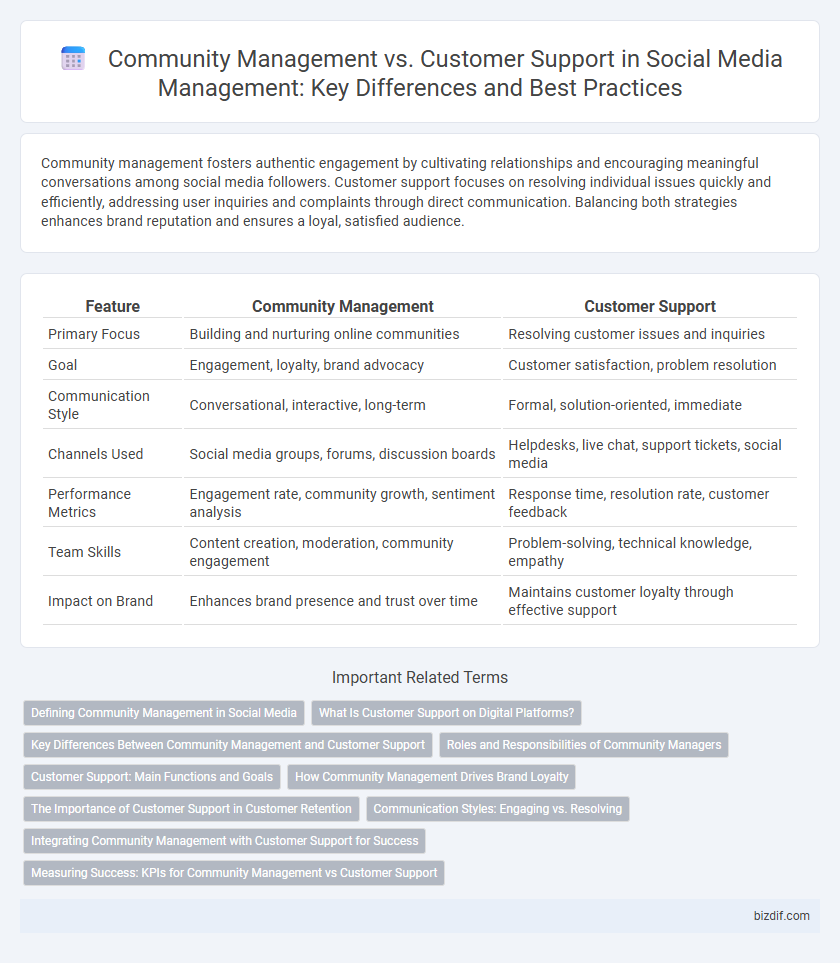Community management fosters authentic engagement by cultivating relationships and encouraging meaningful conversations among social media followers. Customer support focuses on resolving individual issues quickly and efficiently, addressing user inquiries and complaints through direct communication. Balancing both strategies enhances brand reputation and ensures a loyal, satisfied audience.
Table of Comparison
| Feature | Community Management | Customer Support |
|---|---|---|
| Primary Focus | Building and nurturing online communities | Resolving customer issues and inquiries |
| Goal | Engagement, loyalty, brand advocacy | Customer satisfaction, problem resolution |
| Communication Style | Conversational, interactive, long-term | Formal, solution-oriented, immediate |
| Channels Used | Social media groups, forums, discussion boards | Helpdesks, live chat, support tickets, social media |
| Performance Metrics | Engagement rate, community growth, sentiment analysis | Response time, resolution rate, customer feedback |
| Team Skills | Content creation, moderation, community engagement | Problem-solving, technical knowledge, empathy |
| Impact on Brand | Enhances brand presence and trust over time | Maintains customer loyalty through effective support |
Defining Community Management in Social Media
Community management in social media involves building and nurturing authentic relationships with followers through proactive engagement, content moderation, and facilitating meaningful conversations that align with brand values. Unlike customer support, which primarily addresses specific issues or inquiries, community management fosters a vibrant ecosystem where users feel valued and connected, enhancing brand loyalty and advocacy. Effective community managers leverage analytics and social listening tools to tailor interactions and anticipate audience needs, promoting sustained growth and positive brand perception.
What Is Customer Support on Digital Platforms?
Customer support on digital platforms involves assisting users by resolving issues, answering inquiries, and providing technical help through channels like social media, live chat, and email. It focuses on troubleshooting specific problems to ensure customer satisfaction and retention. Effective customer support leverages timely responses and personalized interactions to build trust and foster positive brand experiences online.
Key Differences Between Community Management and Customer Support
Community management centers on fostering engagement, building relationships, and nurturing brand loyalty across social media platforms, while customer support focuses on resolving specific user issues and providing technical assistance. Key differences include the proactive nature of community management aimed at long-term brand advocacy versus the reactive problem-solving approach of customer support targeting immediate user satisfaction. Metrics for community management typically involve engagement rates and sentiment analysis, whereas customer support success is measured by response time and resolution rates.
Roles and Responsibilities of Community Managers
Community managers focus on building and nurturing relationships within social media audiences by facilitating engagement, creating content, and fostering positive brand conversations. Their responsibilities include monitoring social channels for feedback, moderating discussions to maintain a respectful environment, and advocating community needs to internal teams for product or service improvements. Unlike customer support, which addresses individual user issues and troubleshooting, community management aims to cultivate a loyal and active online community that enhances overall brand reputation.
Customer Support: Main Functions and Goals
Customer support in social media management focuses on resolving user inquiries, addressing complaints, and providing timely assistance to enhance customer satisfaction. Key functions include monitoring social channels for issues, responding to messages or comments quickly, and escalating complex cases to specialized teams. The primary goal is to build trust and loyalty by ensuring a positive and effective communication experience across social media platforms.
How Community Management Drives Brand Loyalty
Community management fosters brand loyalty by actively engaging users, encouraging meaningful interactions, and creating a sense of belonging within a brand's online ecosystem. Unlike customer support, which focuses on resolving individual issues, community management builds long-term relationships through consistent communication and shared values. This strategic engagement enhances customer retention, amplifies brand advocacy, and cultivates a loyal community that contributes to organic growth.
The Importance of Customer Support in Customer Retention
Customer support plays a critical role in customer retention by providing timely resolutions, personalized assistance, and building trust with the audience. Unlike community management, which focuses on engagement and brand awareness, customer support directly addresses issues and ensures satisfaction, leading to higher loyalty and repeat business. Efficient support teams reduce churn rates and enhance overall customer lifetime value through consistent, positive interactions.
Communication Styles: Engaging vs. Resolving
Community management emphasizes engaging communication styles that foster interaction, brand loyalty, and active participation within social media audiences. Customer support prioritizes resolving communication aimed at addressing issues, providing solutions, and ensuring customer satisfaction promptly. Effective social media strategies balance engaging community-building conversations with efficient problem-solving responses to enhance overall user experience.
Integrating Community Management with Customer Support for Success
Integrating community management with customer support enhances brand loyalty by creating seamless interactions across social media platforms. Efficient collaboration between community managers and support teams enables faster issue resolution and fosters a positive customer experience. Leveraging social media listening tools and CRM systems streamlines communication, ensuring consistent engagement and proactive problem-solving.
Measuring Success: KPIs for Community Management vs Customer Support
Measuring success in community management centers on KPIs such as engagement rate, sentiment analysis, and member growth, reflecting the health and activity of online communities. Customer support KPIs prioritize metrics like first response time, resolution rate, and customer satisfaction score (CSAT) to evaluate service effectiveness and customer experience. Comparing these KPIs highlights the complementary roles where community management fosters interaction, while customer support ensures problem resolution.
Community management vs Customer support Infographic

 bizdif.com
bizdif.com